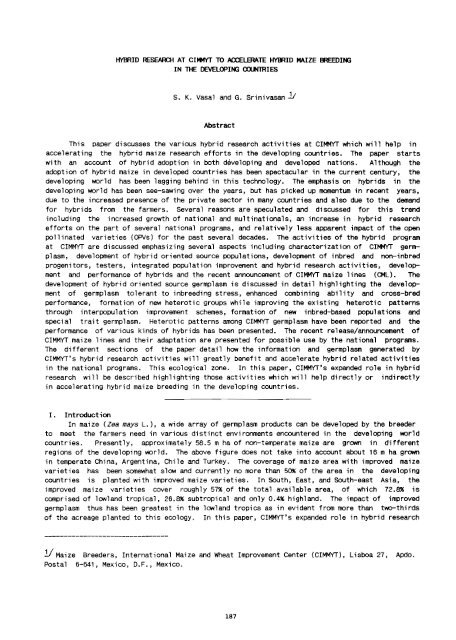Proceedings of the Fifth Asian Regional Maize Workshop - Search ...
Proceedings of the Fifth Asian Regional Maize Workshop - Search ...
Proceedings of the Fifth Asian Regional Maize Workshop - Search ...
You also want an ePaper? Increase the reach of your titles
YUMPU automatically turns print PDFs into web optimized ePapers that Google loves.
HYBRID RESEARCH AT CI~ TO ACCELffiATE HYBRID MAIZE BREEDIOO<br />
IN THE OEVELOPIOO CXUffRIES<br />
S. K. Vasal and G. Srinivasan 11<br />
Abstract<br />
This paper discusses <strong>the</strong> various hybrid research activities at CIMMYT which will help in<br />
accelerating <strong>the</strong> hybrid maize research efforts in <strong>the</strong> developing countries. The paper starts<br />
with an account <strong>of</strong> hybrid adoption in both developing and developed nations. Although <strong>the</strong><br />
adoption <strong>of</strong> hybrid maize in developed countries has been spectacular in <strong>the</strong> current century, <strong>the</strong><br />
developing world has been lagging behind in this technology. The emphasis on hybrids in <strong>the</strong><br />
developing world has been see-sawing over <strong>the</strong> years, but has picked up momentum in recent years,<br />
due to <strong>the</strong> increased presence <strong>of</strong> <strong>the</strong> private sector in many countries and also due to <strong>the</strong> demand<br />
for hybrids from <strong>the</strong> farmers. Several reasons are speculated and discussed for this trend<br />
including <strong>the</strong> increased growth <strong>of</strong> national and mUltinationals, an increase in hybrid research<br />
efforts on <strong>the</strong> part <strong>of</strong> several national programs, and relatively less apparent impact <strong>of</strong> <strong>the</strong> open<br />
pollinated varieties (OPVs) for <strong>the</strong> past several decades. "rhe activities <strong>of</strong> <strong>the</strong> hybrid program<br />
at CIMMYT are discussed emphasizing several aspects including characterization <strong>of</strong> CIMMYT germplasm,<br />
development <strong>of</strong> hybrid oriented source populations, development <strong>of</strong> inbred and non-inbred<br />
progenitors, testers, integrated population improvement and hybrid research activities, development<br />
and performance <strong>of</strong> hybrids and <strong>the</strong> recent announcement <strong>of</strong> CIMMYT maize lines (CML). The<br />
development <strong>of</strong> hybrid oriented source germplasm is discussed in detail highlighting <strong>the</strong> development<br />
<strong>of</strong> germplasm tolerant to inbreeding stress, enhanced combining ability and cross-bred<br />
performance, formation <strong>of</strong> new heterotic groups while improving <strong>the</strong> existing heterotic patterns<br />
through interpopulation improvement schemes, formation <strong>of</strong> new inbred-based populations and<br />
special trait germplasm. Heterotic patterns among CIMMYT germplasm have been reported and <strong>the</strong><br />
performance <strong>of</strong> various kinds <strong>of</strong> hybrids has been presented. The recent release/announcement <strong>of</strong><br />
CIMMYT maize lines and <strong>the</strong>ir adaptation are presented for possible use by <strong>the</strong> national programs.<br />
The different sections <strong>of</strong> <strong>the</strong> paper detail how <strong>the</strong> information and germplasm generated by<br />
CIMMYT's hybrid research activities will greatly benefit and accelerate hybrid related activities<br />
in <strong>the</strong> national programs. This ecological zone. In this paper, CIMMYT's expanded role in hybrid<br />
research will be described highlighting those activities which will help directly or indirectly<br />
in accelerating hybrid maize breeding in <strong>the</strong> developing countries.<br />
I. Introduction<br />
In maize (Zea mays L.), a wide array <strong>of</strong> germplasm products can be developed by <strong>the</strong> breeder<br />
to meet <strong>the</strong> farmers need in various distinct environments encountered in <strong>the</strong> developing world<br />
countries. Presently, approximately 58.5 m ha <strong>of</strong> non-temperate maize are grown in different<br />
regions <strong>of</strong> <strong>the</strong> developing world. The above figure does not take into account about 16 m ha grown<br />
in temperate China, Argentina, Chile and Turkey. The coverage <strong>of</strong> maize area with improved maize<br />
varieties has been somewhat slow and currently no more than 50% <strong>of</strong> <strong>the</strong> area in <strong>the</strong> developing<br />
countries is planted with improved maize varieties. In South, East, and South-east Asia, <strong>the</strong><br />
improved maize varieties cover roughly 57%.<strong>of</strong> <strong>the</strong> total available area, <strong>of</strong> which 72.8% is<br />
comprised <strong>of</strong> lowland tropical, 26.8% subtropical and only 0.4% highland. The impact <strong>of</strong> improved<br />
germplasm thus has been greatest in <strong>the</strong> lowland tropics as in evident from more than two-thirds<br />
<strong>of</strong> <strong>the</strong> acreage planted to this ecology. In this paper, CIMMYT's expanded role in hybrid research<br />
!I <strong>Maize</strong> Breeders, International <strong>Maize</strong> and Wheat Improvement Center (CIMMYT), Lisboa 27, Apdo.<br />
Postal 6-641, Mexico, D.F., Mexico.<br />
187

















